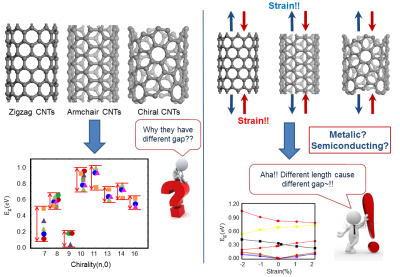Lab Introduction
Members' Pages
Principal Investigator
Research Professor
Ph.D. Students
M.S. Students
Undergraduate Students
- Eunseo Hong
- Ramyun Lee
Using ab initio density functional theory and semi-empirical theories, we have studied various properties and applications of carbon nanotubes (CNTs), which are seamless cylinders wrapped from graphene.
 There are variety of different computational results on the same CNTs
with the same computational method. To resolve this issue, we swapped
completely the configurational spaces of each CNT considering its
structural symmetry determined by either as well as achiral (armchair
and zigzag) and chiral CNTs. As a result, We were able to identify the
most stable structure and the coupling effects between structural and
electronic properties.
There are variety of different computational results on the same CNTs
with the same computational method. To resolve this issue, we swapped
completely the configurational spaces of each CNT considering its
structural symmetry determined by either as well as achiral (armchair
and zigzag) and chiral CNTs. As a result, We were able to identify the
most stable structure and the coupling effects between structural and
electronic properties.
Using Monte Carlo simulations, we have investigated the possibility of an orientational melting transition within a “rope” of CNTs. hen twisting nanotubes bundle up during the synthesis, orientational dislocations or twistons arise from the competition between the anisotropic interbute interactions, which tend to align neighboring tubes, and the torsion rigidity that tends to keep individual tubes straight. We mapped the energetics of a rope containing twistons onto a alttice gas model and found that the onset of a free “diffusion” of twistons, conrresponding to orientational melting, occurs at TOM ≥ 160 K.
 download:
download: 

We explored the effect of intertube interaction in bundles of single-wall CNTs and multiwall CNTs. Because of small intertube interaction and lattice frustration, we predicted very soft libration modes to occur and to disappear above the orientational melting temperature which marks the onset of free tube rotations about their axis. We also predicted such weak intertube coupling causes an additional electronic band dispersion of < 0.2 eV and opens up a pseudogap of the same magnitude at the Fermi level in the rope of (10,10) SWCNTs. In a (5,5)@(10,10) double wall CNT, the weak interwall interaction and the symmetry reduction causes four pseudogaps to open and close periodically near the Fermi level during the soft librational motaion. This electron-libration coupling, absent in solids composed of fullerenes and SWCNTs, may yield superconductivity in MWCNTs.
 download:
download: 

 download:
download: 

 download:
download: 

We investigated the morphology and structural stability at the growing edge of multi-wall CNTs using ab initio and parametrized calculations. We found that the open-ended structures are stabilized against dome closure by strong covalent bonds connecting the exposed edgs of adjacent walls. Growth at the open edge involves rearrangement of these bonds, which are mediated by carbon atoms bridging the gap and change the tip morphology significantly. Presence of a strong ``lip-lip'' interaction can explain formation of carbon nanotubes under annealing conditions.
 download:
download: 
